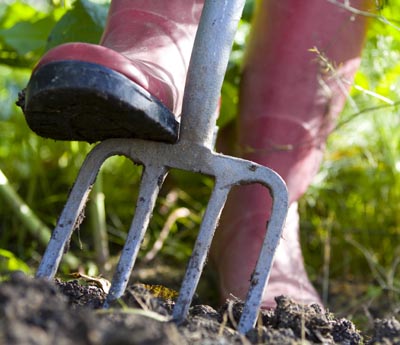Put The Vegetable Garden To Bed
Act now for a better veggie patch in 2020
By Carmine Carosella, Fairfax Master Gardener
Cold weather is coming, and it’s the perfect time to get cracking on next year’s vegetable garden. It’s true: What you do now, in these colorful days of autumn, will have a tremendous impact on the success of next year’s crops. Some crucial steps to take now include removing plant waste, cultivating soil, storing hardware and heavily mulching the garden surface. Of course, you should also record the location and results of this year’s crops.
Removing plant waste
 Get rid of all remaining organic matter; don’t turn it into the soil, as these leftovers can harbor disease and weed seeds that you don’t want to encounter next year. Make sure to remove those tomato vines, the powdery-mildew-covered zucchini plants and all the other bits of tired plant material. If you had bindweed (convolvulus) growing up your tomato cages or fences, be sure to trash those nasty seedpods.
Get rid of all remaining organic matter; don’t turn it into the soil, as these leftovers can harbor disease and weed seeds that you don’t want to encounter next year. Make sure to remove those tomato vines, the powdery-mildew-covered zucchini plants and all the other bits of tired plant material. If you had bindweed (convolvulus) growing up your tomato cages or fences, be sure to trash those nasty seedpods.
Cultivating
Turning the soil with a pitchfork makes more sense now than in the spring. First, you’ll make life miserable for grubs. Second, the soil will be primed to accept mulch and winter moisture better, as well as any lime you put down. (Only add lime if a soil test indicates that the pH needs adjustment.) Finally, fall cultivation lets you start spring planting earlier; spring cultivation must be delayed until the soil dries out.
Mulching
Fairfax gardeners have ready access to free, ground, leaf mulch. (See Free Mulch or call 703-324-5995 for more information). What a treasure! A 6-inch layer of leaf mulch over the garden works wonders. Not only will it completely suppress winter weeds but, as the mulch breaks down, you will soon have that rich, black loam that every gardener relishes. Grass clippings and other mulch materials are also good; just make sure to avoid inadvertently planting weeds and putting poisons into your plot. If you’ve planted winter crops, then the mulch between the rows will control weeds and protect the crops against winter’s hardships. Planting cover crops such as winter rye is an alternative, but mulching is much easier. An edible cover crop such as kale certainly does make sense.
This and that
Every gardener must disassemble and store all those structures built to accommodate the veggies. While you may want to retire bamboo and wood stakes, clean any organic detritus off metal poles and tomato cages and stack them. If you plant vegetables in containers, dump the dirt from the containers, and scrub the pots, perhaps with bleach, to kill all diseases. Use fresh potting soil next year.
And then there is the record keeping. Gardeners should keep a record of what and where they planted this year’s crops. A running record during the garden year is the best approach. Now is the time to finish it off with a summary of the garden layout and the must-do plants for next year. Crop rotation is impractical in many cases, especially if you try to adhere to a three-year cycle, but it is still a good idea to rotate as much as you can. Finally, while you’re putting the garden to bed, why not tuck in a few garlic cloves and some onion bulbs? There’s still time!